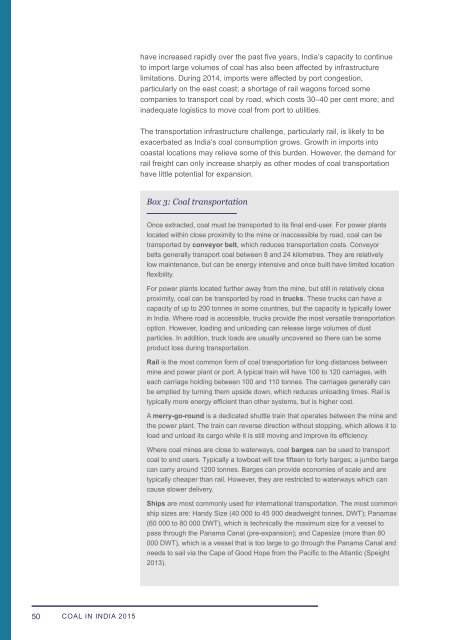Coal in India
1P05mmm
1P05mmm
Create successful ePaper yourself
Turn your PDF publications into a flip-book with our unique Google optimized e-Paper software.
have <strong>in</strong>creased rapidly over the past five years, <strong>India</strong>’s capacity to cont<strong>in</strong>ueto import large volumes of coal has also been affected by <strong>in</strong>frastructurelimitations. Dur<strong>in</strong>g 2014, imports were affected by port congestion,particularly on the east coast; a shortage of rail wagons forced somecompanies to transport coal by road, which costs 30–40 per cent more; and<strong>in</strong>adequate logistics to move coal from port to utilities.The transportation <strong>in</strong>frastructure challenge, particularly rail, is likely to beexacerbated as <strong>India</strong>’s coal consumption grows. Growth <strong>in</strong> imports <strong>in</strong>tocoastal locations may relieve some of this burden. However, the demand forrail freight can only <strong>in</strong>crease sharply as other modes of coal transportationhave little potential for expansion.Box 3: <strong>Coal</strong> transportationOnce extracted, coal must be transported to its f<strong>in</strong>al end-user. For power plantslocated with<strong>in</strong> close proximity to the m<strong>in</strong>e or <strong>in</strong>accessible by road, coal can betransported by conveyor belt, which reduces transportation costs. Conveyorbelts generally transport coal between 8 and 24 kilometres. They are relativelylow ma<strong>in</strong>tenance, but can be energy <strong>in</strong>tensive and once built have limited locationflexibility.For power plants located further away from the m<strong>in</strong>e, but still <strong>in</strong> relatively closeproximity, coal can be transported by road <strong>in</strong> trucks. These trucks can have acapacity of up to 200 tonnes <strong>in</strong> some countries, but the capacity is typically lower<strong>in</strong> <strong>India</strong>. Where road is accessible, trucks provide the most versatile transportationoption. However, load<strong>in</strong>g and unload<strong>in</strong>g can release large volumes of dustparticles. In addition, truck loads are usually uncovered so there can be someproduct loss dur<strong>in</strong>g transportation.Rail is the most common form of coal transportation for long distances betweenm<strong>in</strong>e and power plant or port. A typical tra<strong>in</strong> will have 100 to 120 carriages, witheach carriage hold<strong>in</strong>g between 100 and 110 tonnes. The carriages generally canbe emptied by turn<strong>in</strong>g them upside down, which reduces unload<strong>in</strong>g times. Rail istypically more energy efficient than other systems, but is higher cost.A merry-go-round is a dedicated shuttle tra<strong>in</strong> that operates between the m<strong>in</strong>e andthe power plant. The tra<strong>in</strong> can reverse direction without stopp<strong>in</strong>g, which allows it toload and unload its cargo while it is still mov<strong>in</strong>g and improve its efficiency.Where coal m<strong>in</strong>es are close to waterways, coal barges can be used to transportcoal to end users. Typically a towboat will tow fifteen to forty barges; a jumbo bargecan carry around 1200 tonnes. Barges can provide economies of scale and aretypically cheaper than rail. However, they are restricted to waterways which cancause slower delivery.Ships are most commonly used for <strong>in</strong>ternational transportation. The most commonship sizes are: Handy Size (40 000 to 45 000 deadweight tonnes, DWT); Panamax(60 000 to 80 000 DWT), which is technically the maximum size for a vessel topass through the Panama Canal (pre-expansion); and Capesize (more than 80000 DWT), which is a vessel that is too large to go through the Panama Canal andneeds to sail via the Cape of Good Hope from the Pacific to the Atlantic (Speight2013).50COAL IN INDIA 2015


